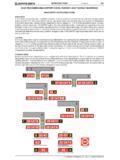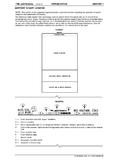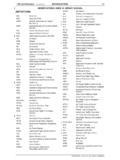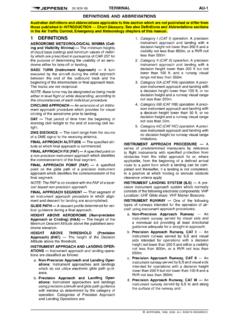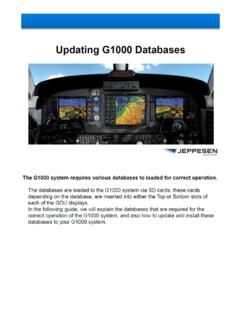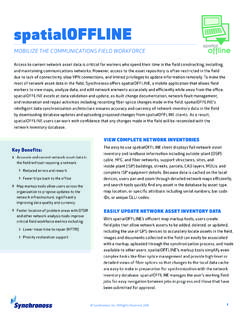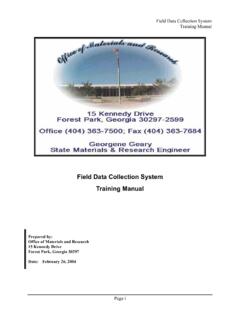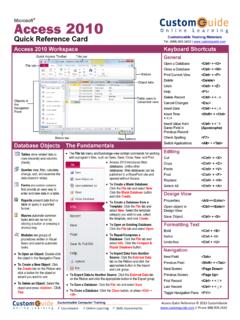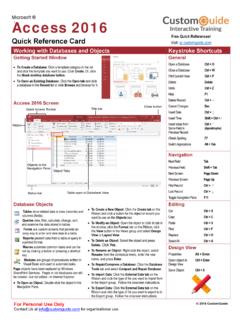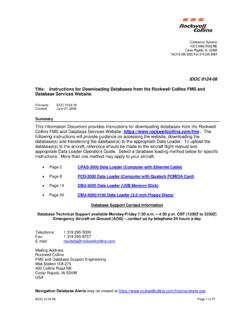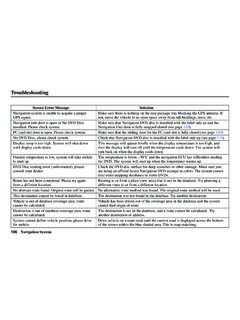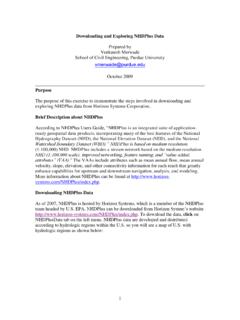Transcription of The Chart Clinic– Database Series - Jeppesen
1 On the Chart and what ATC wanted for departureand arrival procedures. ARINC 424, the world-wide navigation Database standard, was revisedin version three to enable navigation systems tofly without regard to predetermined fixes; but,in the same way they would be flown if the pilotwas to do it all manually. Version three nowmade it possible for the navigation data to beloaded into the airborne systems and fly the pro-cedures automatically with the flight manage-ment systems and the is a path/terminator?
2 In the simplest ofterms, it is a means of prescribing the way inwhich a path is to be flown, and how the path isto be terminated. For every path/terminator,there are two characters in the Database , the firstcolumn specifies the path to be flown and thesecond column specifies how the path should bestopped. As an example, the letters CI indicate that the equipment should fly a courseand that it should end when the next path is all, the ARINC 424 document has a total of 23path/terminators.
3 To implement all 23 path/ter-minators takes an incredible amount of pro-gramming for airborne avionics. As you canimagine, the number of implementations ismuch larger when you consider that each of the23 path/terminators could be followed by eachof the other 23 path/terminators. It is really sig-nificant when you know that most of the avion-ics systems actually are working with twopath/terminators at a time because the nextpath/terminator has to be in memory for activa-tion by the autopilot when the existing leg iscompleted.
4 This requires significant program-ming and therefore not all avionics systems carryall of the path/terminators. Additionally, ARINC424 document does not allow all legs to followall other to a Fix (TF) LegThe most common leg segment type is one thathas been implemented in all avionics systemsthat have an aeronautical Database . It is thegreat circle track between two fixes. In pilot talk that means the magnetic course betweenfixes. This path/terminator is called track to a fixand uses the letters TF in ARINC talk.
5 The TFleg starts at a fix and then proceeds direct TOthe next fix via the track connecting the two airway segments in all databases are TF means that every turn point on every airwaymust be a fix in the Database . And each fixneeds to have an identifier in the Database . Thatis why you see so many computer navigationfixes (CNFs) on the enroute charts. Most inter-sections on the charts have names assigned tothem that are used in pilot/controller communi-cations, but those fixes not required for ATCcommunications show the name/identifier inbrackets on the enroute charts.
6 The CNFs areused for navigation only and are not part of thepilot/controller a navigation standpoint, as soon as any fixis passed, the navigation system switches to thenext waypoint and then proceeds TOthat nextwaypoint. You ve noticed that I have empha-sized the word TO a couple of times. Comparedto VOR navigation where you frequently fly fromthe VOR until passing the cross over point, usingthe TF leg in airborne databases, you will neverfly from a waypoint, but will always fly TOawaypoint. This means you won t have divergingtracks from a fix but will always have convergingtracks to the next fix.
7 Even though the out-bound course from the previous fix is not usedfor navigation , in some avionics systems it isincluded in the Database to display the pub-lished radial from a fix such as a of the advantages of the TF leg is that themagnetic variation makes no difference to theresultant track. One of the problems with sometypes of navigation is that there is an attempt touse magnetic variation to produce the magneticcourse from a computed true course and thenapply magnetic variation. That may soundgood, except, if the magnetic course used bythe avionics is different than that used by thegovernment authorities who design procedures,the resultant magnetic course shown in the air-plane will be different than on the Chart whichreflects the government of the accuracy of the TF leg, the FAAspecified that all final approach segments will becreated using the TF leg.
8 This ensures that allapproaches will fly toward the landing runway(or missed approach point if not on the runway).This also helps the FAA ensure that there will not be any track differences because of magnetic TF leg is one of the few legs that are allowed for new procedures that is designed for RNP RNAV. RNP (required nav-igation perfor-mance) is the newmeans used byICAO and manycountries to speci-fy a type of naviga-tion Chart Clinic Database SeriesJust imagine.
9 Flying an approach where all theautopilot commands for heading select, VORradial capture, descent to preset altitude,course capture, nav tracking, etc. are already inyour Database for your approach. And whatif not only all the autopilot commands werethere, what if all the exact courses and altitudeswere already there for your approach. You mayask, Is that possible? Just thinking about that possibility, you canimagine that sometime in the way-out future, allthat could be carried on board your the reality is that all of those autopilotcommands are in the Database and have beenfor some time.
10 Today, all of the track and alti-tude information with the commands for theautopilot are there for virtually all the approach-es, SIDs, and STARs in the a caveat, even though all the segments andapproaches are in the master Database , not allavionics systems have created the ability for allof the segments to be in airborne , not all autopilots have the connec-tion to the avionics systems to implement all the , you ask, How does all that work? Paths and TerminatorsWhen RNAV was first introduced, the avionicssystems only flew from point to point.

